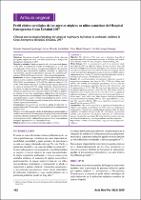Perfil clínico serológico de los agentes atípicos en niños asmáticos del Hospital Emergencias Grau EsSalud 2007
Related Resource(s)
https://amp.cmp.org.pe/index.php/AMP/article/view/1517Date
2009Author(s)
Huamaní Egocheaga, Rómulo
Miranda Candelario, Javier
Mejía Vásquez, Clara
Campos Noriega, Cecilia
Metadata
Show full item recordAlternate title
Clinical and serological findings for atypical respiratory infections in asthmatic children in
Grau Emergency Hospital, EsSalud, 2007
Abstract
Objetivos: Determinar el perfil clínico serológico de la infección
por agentes atípicos en niños con crisis asmáticas en el Hospital de
Emergencias Grau período 2007.
Material y métodos: Estudio prospectivo, de corte transversal durante
el año 2007. Se incluyó una muestra de 90 pacientes de 2 a 14 años
con diagnóstico clínico de asma bronquial que acudieron a Emergencia
de Pediatría por exacerbación asmática, refractaria a tratamiento
convencional, a quiénes se tomó muestra de sangre para Inmunoensayo
indirecto: ELISA Ig M para Chlamydia y Mycoplasma Pneumonaie.
Resultados: Se obtuvo una prevalencia global de infección por agentes
atípicos en niños asmáticos en el 30% (27/90), siendo para chlamydia el
20% (18/90), mycoplasma el 13,3% (12/90) e infección mixta en 3,3%
(3/90). Hubo mayor prevalencia de infección por agentes atípicos en
los meses de invierno (33,3%), siendo chlamydia pneumoniae el más
prevalente en todas las estaciones. En cuanto a edad, no se encontró
diferencias significativas para mayores o menores de 5 años, ni tampoco
en relación al sexo. Las características radiográficas más frecuentes
fueron engrosamiento peribronquial (29,6%), hiperinflación (22,2%) y
opacidades hiliares (22,2%). Si bien el hemograma fue normal en más
del 80% (22/27) de pacientes con infección por agentes atípicos, tampoco
alcanzó significancia estadística.
Conclusiones: Se encontró una prevalencia global de infección por
agentes atípicos del 30% asociado a crisis asmáticas. Hubo independencia
de edad y sexo.
Debemos tener alta sospecha clínica de infección por agentes atípicos
en niños con antecedente de asma persistente que presenten exacerbación
moderada, refractaria a tratamiento convencional, y que además muestren
un hemograma normal y radiografía con predominio de engrosamiento
bronquial, hiperaereación y/o opacidades hilares. Objective: The objective of this study was to determine the profile of
infections caused by atypical microorganisms in children with asthma
exacerbations treated in Grau Emergency Hospital during 2007.
Methodology: This is a prospective and cross-sectional study
performed in 2007, in which 90 patients between 2 and 14 years old
who were brought to the Pediatric Emergency area because of asthma
exacerbations refractyory to conventional therapy were included. A blood
sample was taken from all patients, in order to perform an ELISA indirect
immunoassay test, looking for IgM showing acute infections caused by
Chlamydia pneumoniae and Mycplasma pneumoniae.
Results: An overall prevalence of respiratory infections caused by
atypical microorganisms was found in 30% (27/90) of children with
asthma, 20% (18/90) for Chlamydia pneumoniae, 13.3% (12/90) for
Mycoplasma pneumoniae, and mixed infections (M. pneumoniae and
C. pneumoniae) in 3.3% (3/90). We also found that infections caused
by atypical agents increased in winter (33.3%), while those caused by
Chlamydia were prevalent all over the year. There were no significant
differences in frequency of these infections with respet to age (being more
or less than 5 years old) or sex. More frequent radiological featurees
were peribronchial thickening (29.6%), chest hyperinflation (22.2%),
and hilar opacities (22.2%). CBCs were reported as nromal in more
than 80% of the patients (22/27).
Conclusions: The overall prevalence of atypical microorganisms in
children with asthma exacerbations was 30%, and it was independent
of age and sex. We must have a high clinical suspicion index for theses
conditions in children brought to the ER with history of persistant
asthma withy moderate exacerbations refractory to conbventional
therapy who also have a normal CBC and a chest X-ray pattern showing
peribronchiaal thickening, chest hyperinflation, and hilar opacities
Collections
- Artículos científicos [890]






